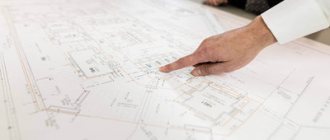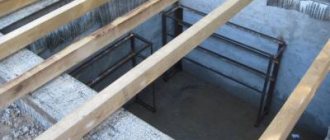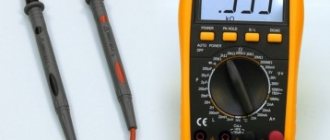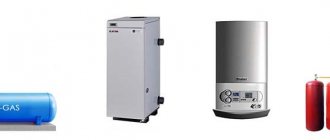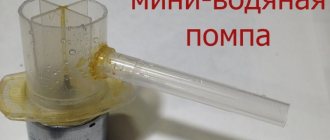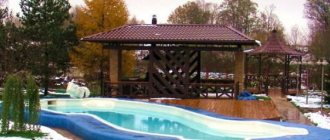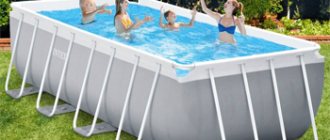On weekends, many residents of our homeland strive to quickly go to their dacha from their cities to breathe fresh air, enjoy nature and take a break from the bustle of the city. And if you have a swimming pool, then the question arises: How to heat a pool in the country?
Swimming in cold water is not fun. And if children also swim with you, they can easily get sick.
Let us remind you that the comfortable water temperature in the pool for an adult is from 25 degrees Celsius, and for children - from +29 degrees.
Today we’ll look at what methods we can use to heat a pool at the dacha. Moreover, we will consider both the devices offered by manufacturers and traditional methods.
Pros and cons of water heaters
The benefits of using gas pool water heaters include the following:
- high efficiency and heating speed;
- ability to work autonomously;
- absence of combustion products;
- simple operation;
- wide selection of models.
Disadvantages of the device:
- the need for a constant gas supply of acceptable pressure;
- constant monitoring of gas leaks;
- strict requirements for the room where the device is installed;
- complexity of connection (services of qualified specialists are required);
- the need for professional service;
- regular monitoring of equipment performance.
Design and principle of operation
The gas burns in the heater, releasing heat, which is transferred to the water passing through the circuit of the device.
The heat exchange device does not heat the water directly. This is an optimization element that increases the efficiency of heat exchange between 2 media: water in the pool and coolant operating from a heat source.
Inside the heat exchanger, they are separated by a system of thin tubes or plates made of a material with high thermal conductivity. The larger the area of this contact, the greater the amount of heat that manages to move from a more heated environment to a less heated one.
A high degree of efficiency and cost-effectiveness of equipment is achieved through the use of natural fuel. The power of the gas heater starts from 115 kW. Propane ensures stable maintenance of a comfortable water temperature for a long period of time.
The simplest solar water heater - DIY instructions
From scrap materials you can make simple solar water heaters that are highly efficient in the summer. Cellular polycarbonate and plastic bottles will serve as a good basis for creating such devices.
Made from cellular polycarbonate
First, a frame is made from a wooden beam. Then a coil is welded from copper tubes in which water will circulate. At its ends, fittings are installed to connect the supply and discharge pipes.
The water heater can be made of cellular polycarbonate.
Plywood is attached to one side of the frame, and insulation is placed on top of it. After this, the coil is fixed to the frame. The top of the structure is covered with a polycarbonate sheet. The finished collector is connected to the pump. In addition, a pipe is installed that drains the liquid back into the pool. You can then turn on and test the system.
From plastic bottles
For the manufacture of the device, containers with a volume of 1.5 liters are better suited. A hole should be drilled in the bottom of each of them, the diameter of which should coincide with the neck. Then one bottle is inserted into the other, secured together with a drilled cap. The connections should be soldered so that they are airtight. In this way, 5-6 containers are fastened in a row.
You need to make at least 5 of these batteries. They are connected to each other with a hose to form a coil. The bottles are painted black. Then the formed coil is placed in a pre-made housing, in which the inlet and outlet holes are made. The top of the heater is covered with transparent polycarbonate or glass.
How to choose?
Gas heaters have the following technical characteristics:
Maximum operating temperature: shows how hot the gas heater coolant can be.- Thermal power: depends not only on the contact area between the two media, but also on the type of liquid being processed.
- Throughput (measured in cubic meters per hour): this parameter shows the time during which the entire volume of water in the pool will pass through the heat exchanger.
After determining the appropriate parameters for the technical characteristics of the gas heater, the required power of this device should be calculated.
To do this, you need to take into account factors:
- pool volume;
- volume of constant heat loss;
- heat source power;
- coolant temperature;
- desired pool water temperature;
- the time period during which water needs to be heated, provided that it has just been collected.
It is advisable to select the power of the equipment corresponding to the maximum level of heat loss. This is enough to maintain an acceptable water temperature during peak loads on the system.
The rules for saving resources are also observed. The lower power limit is selected with a coefficient of 0.7 from the volume of the pool bowl.
Next, you need to calculate the acceptable power of the heat exchanger. To do this, use the formula P = ((V*C * ΔT)/t1) + q*S, where :
- P – required heat exchanger power (W),
- C – specific heat capacity of water at a temperature of 20°C (W/kg*K);
- ΔТ – difference in temperature of cold and hot water (оС),
- t1 – optimal time for heating the entire pool (hours),
- q – heat loss per hour per square meter of water surface (W/m2),
- V – volume of water in the pool (l).
The obtained result is compared with standards. For example, for an outdoor pool, the acceptable power of a gas heater is 1000 W/m2; if the pool is partially closed (a canopy or part of a building), the power should be 620 W/m2. For indoor pools, the described parameter should correspond to 520 W/m2.
An important parameter is the operating time of the heat exchanger to heat the water in the pool to the required value. The calculation is carried out using the formula t = 1.16 * V * T / P, where :
- t – required time in hours;
- V – volume of water in the pool in cubic meters;
- T – required temperature difference in degrees;
- P – declared power.
For example, the initial temperature of the water in the pool is 20 degrees Celsius. It needs to be heated to 26 degrees. The temperature difference is 6 degrees. The volume of the bowl is 30 cubic meters. A heat exchanger with a capacity of 6 kW is also installed. By calculation we get the value 34.8 hours.
Boiler models for heating water with gas, prices
Popular models of gas heaters for swimming pools are the following:
Vanward Tankless
Affordable gas pool heater made in China. Suitable for small medium bowls for home use . Compliance with ISO9001 standards certifies the high quality and safety of the product.
The compact size of the device allows it to be installed in limited spaces. The average cost of such a heater is from 15,000 to 16,000 rubles.
Volcano
Gas heaters of the Vulcan brand are compact, easy to use and efficient . Suitable for stationary, quickly installed and swimming pools.
The supply type of heater requires its connection to a water filtration system, the productivity of which should be in the range from 2 to 9 thousand liters per hour. The cost of the model is 30-35 thousand rubles.
Davey
Davey gas heaters are suitable for large-volume amateur and professional pools. They are used in SPA centers, swimming establishments and private residential properties (country houses, cottages, dachas).
HSI (hot surface ignition) technology has been introduced, which reduces fuel consumption by reducing pilot light consumption. The average cost of the model is about 220-250 thousand rubles.
Features of pools with filtration
Some models have a filtration system. More often it is in the form of a pumping mechanism that mechanically purifies the water and removes all debris. Alternative methods are chemical and manual.
Automatic filtration systems also operate using electricity. Although they are mainly located outside the structure, it is still recommended to follow safety rules: the pump can become very hot, and chemicals should not be used close to bathing.
How to connect to the tank?
Installation and configuration of such equipment for the pool requires highly qualified specialists. Connection is carried out in accordance with the attached instructions. In general, the connection algorithm consists of the following steps:
- Installing the heater on a flat surface near the pool.
- Connecting the hose from the filter system to the lower pipe of the heater.
- Turning on the filter system and releasing air from it.
- Connecting the reducer to the gas cylinder.
How to use?
To start heating, it is enough to provide gas supply to the device and turn on the equipment with the appropriate switch. Next, after the operating time of the heat exchanger, previously calculated by the appropriate formula, you need to check the temperature in the pool.
It should correspond to the expected value: swimming pools, sports pools - from 24 to 26 degrees Celsius, children's pools - from 28 to 30 degrees Celsius, pools for hydromassage and similar water treatments - from 32 to 38 degrees Celsius.
The best manufacturers
Before buying a VB in an online store, you need to determine which model from which company will perform its functions better. In this matter, recommendations from the owners of such equipment will be a good help. In most cases, they advise purchasing devices from the most well-known companies. They always have good performance characteristics and function reliably for a long time.
The most popular manufacturers:
- Intex (Netherlands);
- TeploMax (Russia);
- Bestway (China);
- Dymoff (Russia);
- Pelletron (Russia);
- PAHLEN (Sweden).
Other methods of heating an artificial reservoir
Let's look at what devices can be used to heat the water in the pool.
Geyser
The water in the pool can be heated using a household gas water heater .
However, it must be taken into account that this method is only suitable for small-volume remote pools. They are installed on a temporary basis at dachas or on the territory of a country house.
The power of the column must be at least 20 kW. You can easily purchase such a product in any specialized store at a cost of 3 to 6 thousand rubles.
Gas cylinder
Gas can be supplied from a gas cylinder . To connect equipment to such a cylinder, you should first of all pay attention to the thread of the nut (in many heater models the nut has a left-hand thread) that secures the heater connection point. You need to screw it counterclockwise as tightly and carefully as possible.
Next, open the cylinder valve. To do this, you need to rotate it counterclockwise. At this time, you should finally make sure that there is no gas leakage from under the nut.
To make sure that gas does not flow into the burners, you need to unscrew the fuel supply control screw located on the reducer. This is also done counterclockwise until the value on the pressure gauge reaches 0 MPa. Next you need to light the burner.
Before starting you should check:
- is the water circulation turned on?
- are there any leaks;
- is a reducer connected to the cylinder;
- Is the valve open?
Ignition is carried out with a special gas lighter. This is the easiest and safest way to properly light a burner.
When turned on, it is brought to the burner and at the same time the gas supply screw is rotated clockwise. After ignition, you need to set the value to 0.1 MPa on the pressure gauge for stable operation.
Thermal insulation to keep you warm
Thermal insulation is another way to protect the bowl from thermal energy leaks . For in-ground pools, insulation is critical—if insulation is not installed during construction, heating the water will be very difficult and expensive.
For frame or inflatable pools, it is recommended to lay a heat-insulating foam layer on the platform using a warm underlay. It is also useful to install sides around the bowl to protect it from the wind.


